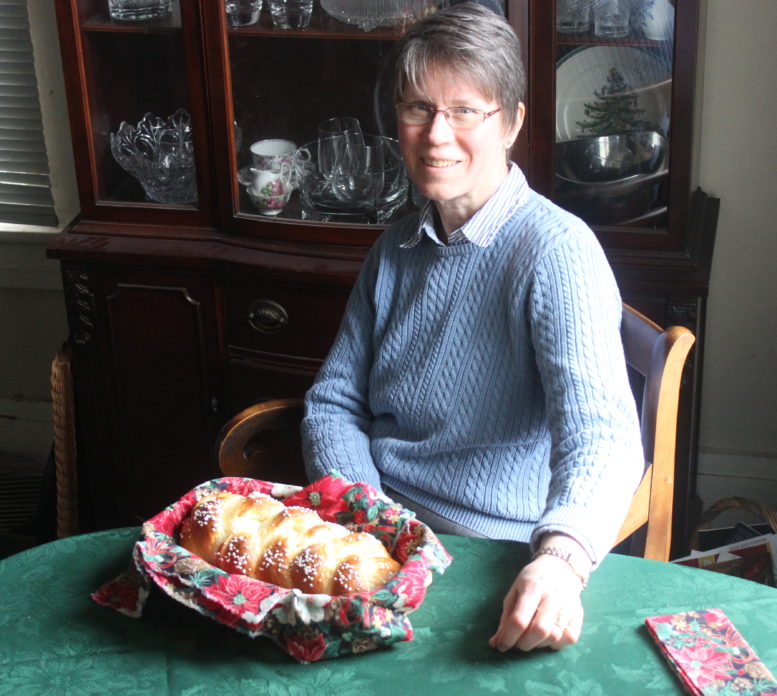By DAVID DUPONT
BG Independent News
Before I ever met my wife, Linda, I had tasted her Finnish sweet bread. At least, I was supposed to.
She’d gone to the home of mutual friend, to bake the bread known as pulla. It was Christmas time, and that friend, Barbara, then my girlfriend, gave me a loaf as a gift. Two days later, she spotted that loaf still sitting on the shelf in my truck. I was right and properly scolded. A Christmas memory. I’m sure, though, that the bread still tasted wonderful toasted.
That was the Christmas of 1973. Now it’s the Christmas of 2017, and Linda is still baking pulla. Lots of it. This year 32 loaves for family and friends near and far. For that matter, Barbara, still a close friend, bakes it as well, serving to her fellow cast members in the Christmas Revels held in Hanover, New Hampshire.
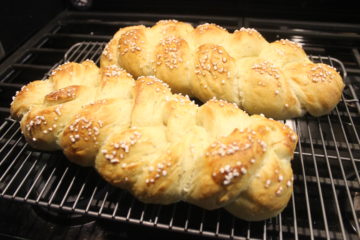
For all that, Linda will point out: Pulla is not a Christmas treat. In Finland it is a year-round staple. There’s always a loaf in the bread box to serve with coffee. To serve coffee without pulla, is considered “bare coffee.”
Nothing “bare” about pulla, a white bread rich with milk, eggs, butter, sugar, and seasoned with cardamom.
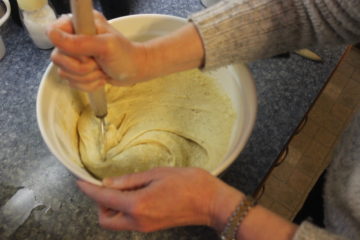
Mixing the dough
Growing up on the Keweenaw Peninsula, which is the upper peninsula of Michigan’s Upper Peninsula, she remembers her mother making it throughout the year. Not always. It was a special treat. The bread was not called “pulla,” it was “nisu,” an archaic word for wheat. The Finnish spoken on the Keweenaw is rich with archaic words spoken by those like Linda’s grandparents who came to the Copper Country at the end of the 19th century.
When Linda’s Aunt Gertrude traveled to Finland in the 1970s, she confused the Finns with her fluent Finnish. “Ma’am, when did you leave Finland?” they wondered.
Linda doesn’t remember when she started to help making the bread. Age 6, maybe?
She loved to punch down the dough after the first rising. Maybe she would help knead, or mix in flour. When she was older she would help remove the cardamom seeds from the pods.
This is the secret of a good pulla. (After spending two years in Finland, Linda adopted that name, though on the Keweenaw it’s still known as nisu.)
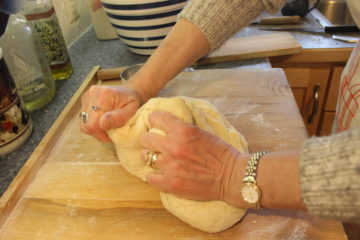
Kneading
“Don’t skimp on the cardamom.” That’s the watchword. Linda uses the same recipe as her mother and her grandmother before her. This is the same recipe as appears in Beatrice Ojakangas’ The Finnish Cookbook. In discussing this all important matter of cardamom, Linda mentioned she uses a generous tablespoon, which is more than Ojakangas calls for. Checking the recipe, she found it’s a full three times as much as the single teaspoon in the recipe.
This year on receiving his pulla shipment, her brother remarked he could smell the cardamom as soon as he picked up the box.
The cardamom must start in seed form. Commercially ground cardamom lacks the oomph. Best is seed already removed from the pod, but Tiger Bakery in Toledo has stopped carrying that. The shop still carries it in pods as does Calico Sage & Thyme here in Bowling Green.
Now after the length of an entire Christmas CD shelling cardamom seeds, one can definitely understand the appeal of the shortcut of using ground spice. Don’t.
The seed must then be crushed. That can be done in a mortar and pestle. Linda’s mother used a bit of old sheet and a hammer. Young Linda liked that part of the job. Now she has a coffee grinder dedicated to spices, mostly cardamom for pulla.
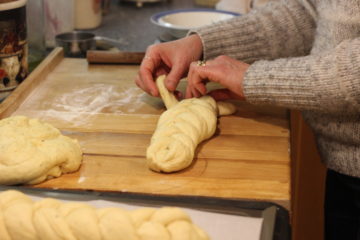
Braiding
The bread itself is a day-long process. Starting with scalding, then cooling and skimming, the milk. Mixing the dough, and two long risings. For a batch that turns out four one-pound loaves, the dough will expand to fill a large bread bowl. She punches it down, and it rises again.
Now some of you may be aware that I’m a regular bread baker, almost all using sourdough as leavening. I pretty much keep out of the pulla, except for shelling the cardamom, and occasionally punching down the dough.
There’s a certain dialogue that goes on between our processes. I’m all about time and temp determining when to move a bread through the fermentation process. I fold dough, not punch it down.
To rise, the dough is set covered on the heating vent. In this house of bread bakers, we’ve been known to keep the temperature on the cool side for ourselves, but knock it up a few degrees for a bowl of bread dough.
Now this can all be done in a day, though the dough can be retarded (technical term for slowing dough fermentation by refrigeration) overnight in the fridge or if the weather’s right, porch or breezeway. If you do that, the dough does not have to warm before handling.
Once risen the dough is divided and braided, then rests while the oven fully heats. Don’t shorten the pre-heating time. Once the oven comes to temp give it at least 10 minutes before putting bread in, especially if you’re using a stone. You want the stone fully heated to its core.
The bread emerges golden brown and fragrant. The house fills with the sweet smell. Then the cooled loaves are wrapped. Early on, they are stacked like cord wood in the freezer for future distribution.
The recipe below was written for our children should they ever take up the mantle of pulla baking. It has skipped over to my side of the family. My sister-in-law Cheryl makes it, and not just at Christmas.
Once, a friend living on the West Coast served Linda pulla, exclaiming about this “Swedish” sweet bread recipe she’d received from her sister. It was Linda’s own recipe. She could tell. The friend had not skimped on the cardamom.
Pulla
1 package dry yeast (2 ¼ tsp.)
½ cup warm water
2 cups milk, scalded and cooled to lukewarm
1 cup sugar
1 tsp. salt
3 tsp. (1 TBSP) cardamom seeds, crushed (See note 1.)
4 eggs, beaten
8-9 cups white flour (I use bread flour, but all-purpose flour works too)
½ cup melted butter
Glaze
1 egg, beaten
1-2 tbsp. Swedish pearl sugar (or crushed lump sugar. See note 2.)
½ cup sliced almonds (optional)
Dissolve yeast in warm water. Stir in milk, sugar, salt, cardamom, eggs and about 2 cups of flour – enough to make a batter. Beat until dough is smooth and elastic. Add about 3 cups of flour and beat well; the dough should be quite smooth and glossy. Add the melted butter and stir in well. Beat again until the dough looks glossy. Stir and knead in the remaining flour until a stiff dough forms. (I usually end up using a total of 8 ½ to 9 cups.)
Turn out onto a lightly floured board and cover with an inverted missing bowl. Let dough rest for 15 minutes. Knead until smooth and satiny. Please in a lightly greased mixing bowl, turn the dough to grease the top, cover lightly, and let rise in a warm place (about 85 degrees) until doubled in bulk (about 1-3 hours.) Punch down and let rise again until almost doubled.
Turn out again onto a lightly floured board, divide into 4 parts, then divide each of these into 3 parts. Roll each part between palms or between palms and the board to shape each part into a strip about ¾ inch in diameter – about 15-18 inches long. Braid 3 strips together into a straight loaf; pinch ends together and tuck under. Repeat for each of 4 loaves. Lift the braids onto lightly greased baking sheets. I usually bake two loaves on one baking sheet. Let rise for 20-30 minutes until puffy, but not doubled in size.
Glaze the loaves by brushing with the beaten egg, and if you wish, sprinkle with the sugar and almonds.
Bake in a hot oven (400 degrees) for 25-30 minutes, until light golden brown.
NOTES:
- Regarding cardamom, the best flavor comes from using whole seeds and crushing or grinding them. I avoid commercial ground cardamom. Whole cardamom seed (not in pods) is available from the Tiger Bakery in Toledo or a Lebanese grocery.
- I never measure this, but just sprinkle on enough to look right. Swedish pearl sugar, a non-melting sugar, is available from King Arthur Flour bake store online. Crushed sugar cubes or just plain sugar works too, but will melt far more readily.
– Linda Brown

